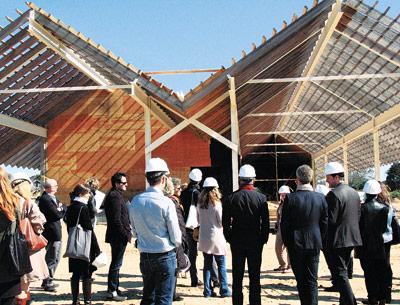Parrish Architecture Unveiled

Members of the metropolitan area media donned hard hats last Thursday to catch up with the progress of the new Parrish Art Museum in Water Mill, which is anticipated to open to the public in the fall of 2012.
Those whizzing by, or crawling by, depending on the time of the day and the busy-ness of Hank’s Pumpkin Town across the Montauk Highway, may have been mystified by the extremely long, low building rising up out of a field on the north side of the highway. Although many had questioned why it seemed to occupy so much of the lot, in actuality, it does not. There is plenty of room both front and back. In order to flood the galleries with the intended mix of light to illuminate the artwork without overwhelming it, the building was placed on an axis allowing its windows to face true north.
“The idea is to give the works the same kind of light for viewers that the artists were experiencing when they were making them,” Terrie Sultan, the Parrish’s executive director, said. Color-balanced fluorescents will supplement the light on less than ideal days or after dark.
The project had a few iterations, the first being a kind of figure-8 amalgamation of studio-like spaces. This turned out to be overwhelming financially in the economic downturn, so rather than wait, perhaps indefinitely, for a dream that may never be realized, the Parrish’s board decided to build something else, enlisting the same architectural firm Herzog and de Meuron to do the redesign.
Pierre de Meuron, a partner in the architectural firm, said on Thursday it was his first time seeing the site since construction started. “We were happy to have been able to work with these conditions,” and about half of the original budget. “This proves we can do strong architecture for less money. It’s a strong statement to make during difficult times.”
At 34,500 square feet, the structure is about half the size of what was first envisioned. Ms. Sultan said its design was practically “activated by the sky” — its changes during the day and over the seasons.
The land surrounding it will “emulate the progression of the landscape of eastern Long Island,” she said, with a wetland meadow on the south side and several kinds of indigenous plants increasing in size from shrubs to trees so “that the building will look like it just arrived on the property.” The parking lot will be screened from the building and its neighbors.
With 2,600 artworks in the permanent collection, an aggressive acquisitions program, and only 4,500 square feet of exhibition space in the existing facility, on Job’s Lane in Southampton Village, those involved thought a new structure was sorely needed. The museum has had to alternate shows of work from the collection with loan exhibits, while the new building will allow them to be mounted simultaneously.
There will be 12,000 square feet of exhibition space. Plans are to have significant elements of the permanent collection always on view in 7,500 square feet, with other exhibits in the remaining space. The new facility will also have a shop, cafe, offices, storage space, and a loading dock, in addition to a multipurpose room for talks, presentations, and performances.
As the final plans began to take shape, the emphasis on the artists of eastern Long Island began to radiate as far west as Setauket, with William Sidney Mount, and as far east as Montauk, with Andy Warhol and others. The first installation in the new building will address the direct relationship between artists and the region’s landscape as well as how other artists took a less literal path from inspiration to result.
It will begin with a celebration of the area’s living artists, showing work from the 1970s to the present. They will include process artists, such as Lynda Benglis, Mary Heilmann, Malcolm Morley, Alan Shields, Keith Sonnier, and Joe Zucker, and figurative artists, such as Ross Bleckner, April Gornik, and Donald Sultan. Straddling both is Chuck Close, whose process is central to his art-making although the end result is a facial likeness.
The museum will then bring the focus back to the landscape with a gallery of works by William Merritt Chase, Childe Hassam, John Frederick Twachtman, and later works by Jane Freilicher, Sheridan Lord, and Jane Wilson.
Chase will also receive his own gallery of portraits and other
paint-
ings along with photographs from the museum’s archives. Fairfield Porter will also be allotted his own space. A resolute figurist, Porter exemplified the duality of artistic inspiration from the South Fork’s art community and its landscape.
“Esteban Vicente: Portrait of the Artist” will focus on the artist’s studio practice and the circle of artists from whom he drew influences and friendships. Similarly, the exhibit “In the Company of Friends” will draw upon the artists of the 1950s and ’60s, who reacted to the primacy of Abstract Expressionism in unusual ways. These artists will include Dan Flavin, Roy Lichtenstein, Alfonso Ossorio, Larry Rivers, and Leon Polk Smith.
Interior galleries that are not directly lit by the sun will display works on paper and, in the inaugural show, photographs of many East End artists at work.
